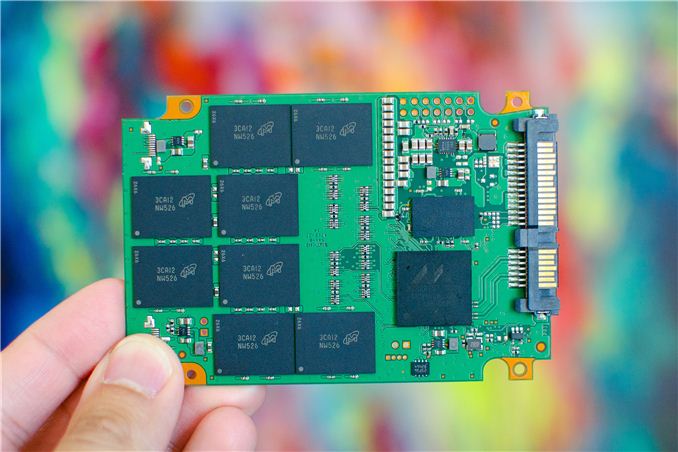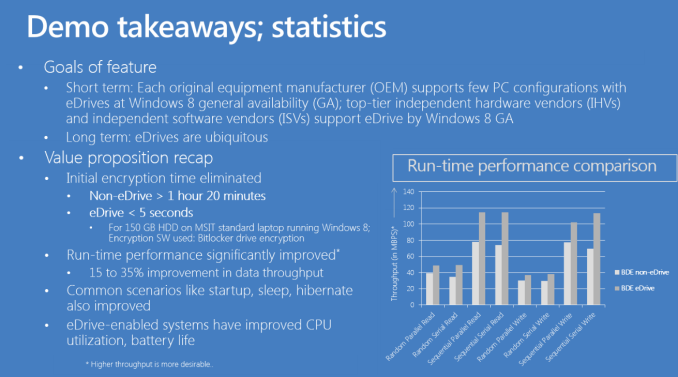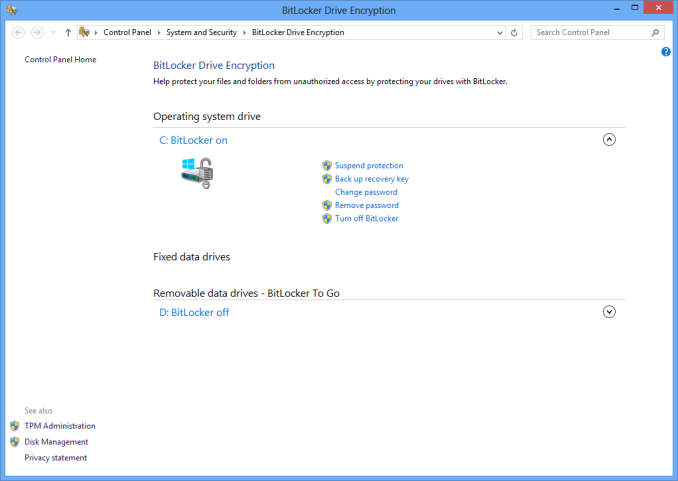Hardware Accelerated BitLocker Encryption: Microsoft Windows 8 eDrive Investigated with Crucial M500
by Anand Lal Shimpi on April 10, 2013 1:28 PM EST
Most modern SSDs come with some form of hardware encryption. On these drives with hardware encryption, it’s usually permanently turned on - all data written to the NAND is typically stored in encrypted form. This stems from the fact that all writes to NAND had to be scrambled to begin with (writing long repeated strings of data to NAND can cause problems for data retention). The earliest implementations weren’t sophisticated enough to be considered real encryption, but these days it’s not uncommon to see hardware AES-128/256 support.
The bad news has been that relying on OS driven filesystem encryption always meant the use of software encryption on top of your drive’s native encryption. This was particularly a problem on SandForce based drives, where full disk encryption basically ruined any of the performance advantages of the controller’s native compression/de-dupe (you can’t further reduce encrypted data). Other drives suffered (just not as much) due to the added overhead from having to leverage the host CPU to encrypt all data before writing it to disk. There’s also the fact that if you encrypt your entire drive (free space included), the drive ends up looking like a completely full drive - which has performance implications of its own. This was the world that existed with BitLocker under Windows 7 and FileVault under OS X.
With Windows 8, the story is a bit different.
I hadn’t heard of Microsoft’s eDrive standard for Windows 8 until I started working on the Crucial M500 review. It turns out that if you have a storage device (e.g. SSD, eMMC, etc...) that meets the right encryption standards, Windows 8’s BitLocker will leverage the device’s hardware encryption engine, bypassing the software based encryption altogether. The result should be better performance and lower power consumption.
The M500 is the first drive that I’m aware of to support Microsoft’s eDrive standard. Because of its TCG Opal 2.0 and IEEE-1667 compliance, the M500 is eDrive compatible. There are some platform requirements to get eDrive working as well. You’ll obviously need a system that will support BitLocker (although hardware TPM isn’t necessary, you can still go the USB key route). It’s important to note that you have to enable UEFI boot and make sure you have a UEFI enabled Windows 8 install in order for this to work. Your platform will specifically need to support UEFI 2.3.1 (Class II no CSM/Class III). Often times UEFI boot support on motherboards can be tricky, particularly on earlier firmware revisions, so be sure you’re updated (this was the problem I ran into with my test hardware). I've had varied luck with getting DIY desktop PC hardware to behave appropriately with UEFI and BitLocker enabled, so your mileage may vary. The experience on a TPM enabled notebook should be far cleaner from what I've heard.
With all of your ducks in a row, all you need to do is enable BitLocker at this point. If everything is eDrive compliant you won’t be asked whether or you want to encrypt all or part of the drive, after you go through the initial setup BitLocker will just be enabled. There’s no extra encryption stage (since the data is already encrypted on your SSD). If you’ve done something wrong, or some part of your system isn’t eDrive compliant, you’ll get a progress indicator and a somewhat lengthy software encryption process.
For example, with 107GB in use my test 240GB M500 was fully encrypted with BitLocker enabled after a couple of seconds. Just a pause, then boom, BitLocker was enabled. My 256GB Samsung SSD 840 Pro on the other hand took about 21 minutes to encrypt the very same data using software encryption.
The gallery below shows all of the steps I went through to enable BitLocker/eDrive support on my Intel DX79SI motherboard with Crucial’s M500.
The ability to quickly enable/disable BitLocker is a nice perk, but it’s only part of the story. There’s basically no change in performance with BitLocker enabled on the M500 since the encryption is all done on the drive (and was always being done there to begin with).
| PCMark 7 - Raw System Storage Score | |||||||||||||
| Unencrypted | BitLocker Enabled | Perf Impact | |||||||||||
| Crucial M500 240GB (eDrive) | 4644 | 4586 | -1.2% | ||||||||||
| Samsung SSD 840 Pro 256GB | 6195 | 5336 | -13.9% | ||||||||||
The sad reality is, Samsung’s 256GB 840 Pro with software encryption enabled ends up being faster than the M500 running as an eDrive, but in theory if the drives were equal performers you’d see a clear advantage to the eDrive compliant hardware. PCMark 7 isn’t the most stressful test and we’re really only measuring peak performance here however. Given that the 840 Pro should look like a completely full drive with its free space encrypted, I ran a short 4KB random write test to see whether or not that was the case:
| Peak Performance - 4KB Random Write (8GB LBA Space, QD32) | |||||||||||||
| Unencrypted | BitLocker Enabled | Perf Impact | |||||||||||
| Crucial M500 240GB (eDrive) | 63334.8 IOPS | 62865.8 IOPS | -0.7% | ||||||||||
| Samsung SSD 840 Pro 256GB | 88911.3 IOPS | 63097.53 IOPS | -29.0% | ||||||||||
Now this is much more interesting. On a mostly empty drive, the 840 Pro behaves like it’s full of data and thus shows lower peak 4KB random write performance. The M500 on the other hand behaves like it’s empty. As neither one of these drives has the best behavior after extended usage in a full state, the long term performance benefits are tremendous.
There should be power savings associated with running as an eDrive, although since my testbed is a desktop PC they aren’t all that visible. The irony here is that none of the modern (UEFI 2.3.1 hit in mid 2011) PC notebook hardware I have on hand will support a 2.5" SSD.
As someone who regularly uses full disk encryption, I can’t tell you how excited I am at the thought of eDrive compliant SSDs. There’s absolutely no reason this shouldn’t be how all OS level encryption works. Kudos to Microsoft for making this happen and to Crucial for supporting it.
I’m hoping we’ll see more eDrive compliant SSDs in the future. For now, anyone who is required to run with BitLocker enabled should seriously consider Crucial’s M500.
On the Mac side, I do hope Apple will follow Microsoft’s lead here and build similar support in to OS X for FileVault. The power and performance savings are worth it, especially when you consider that SandForce based SSDs are now in Apple’s official parts bin.


















46 Comments
View All Comments
lecaf - Thursday, April 11, 2013 - link
"which invalidated all the recovery keys."Thats interesting, I hope you had the dev team look into this, as this seems like a bug, and should never happen.
"Moral of the story, don't make any UEFI security changes"
..or pause Bitlocker before doing them :)
taltamir - Monday, June 24, 2013 - link
"But the real proof has to do with one word: profits. If there were backdoors Windows would be disqualified for government and enterprise use. Profits go bye-bye. There are no backdoors."Verisign had a backdoor which was made for the US government. And yes, it was catastrophic for their reputation when it came out. But you can't claim that no business will ever do it, because businesses did. And the US government used it despite having a backdoor in it.
B3an - Wednesday, April 10, 2013 - link
Why have i never seen this Win 8 feature mentioned anywhere else before? I always keep up to date on Windows news but this don't seem to have been posted anywhere.B3an - Wednesday, April 10, 2013 - link
Very nice feature BTW. Shame my 840 Pro's don't support it!iuqiddis - Thursday, April 11, 2013 - link
Does anyone know how well the linux kernel supports the hardware encryption already present in these SSDs? Or is the only choice to use software encryption? Thanks.Rick83 - Thursday, April 11, 2013 - link
Whether or not hardware or software encryption are a choice on SSDs is still hotly debated on the dm-crypt mailing list. dm-crypt does support external crypto-engines, but due to the device-mapping nature of the implementation, I'm not sure how well it would work to take into account such integrated solutions.mayankleoboy1 - Thursday, April 11, 2013 - link
Dont know about hardware encryption, but Linux kernel is adding a AVX2 based software encryption!gattacaDNA - Monday, May 13, 2013 - link
Unless you are running some of the latest kernels with the right cryptlib packages and then edit / tweak about 4 or 5 different system files, the latest fedora 18 does not even support SSD Trim. The default state of TRIM is OFF. I know b/c I just went thru quite a quest to turn it on. Cannot comment on anything like eDrive but I'll take a _properly implemented_ drive password on the right platform, one who's UEFI/BIOS is designed to handle longer / extended passwords over nothing. Cheers.Tjalve - Thursday, April 11, 2013 - link
This is awsome news. Ive been knowing abolut the windows 8 support for a long time, however i never found any information on what standards needed to be supported, and none of the drives I tested this on, worked.So its my understanding that you need to enable UEFI and boot with UEFI. Does that mean that you need to reinstall the OS aswell?
Azethoth - Thursday, April 11, 2013 - link
No, secure boot does not require you to re-install the OS. However, and this is a big hairy however, every other device during boot needs to be signed as well. Sadly this gives you a >>>50% chance that your graphics card is going to screw you. For Radeon the chance is 100% - the chance you are a lucky Powercolor or something owner. For nVidia they have a firmware update for one of their GPU's. Outside of those two cases you are 100% screwed.For AMD you will not even find an official notice, but Googling will find a snippet that someone quotes indicating they suck at doing it.
Gah, this new comment code looks nice but sucks for disabling the Chrome expandable text entry box.